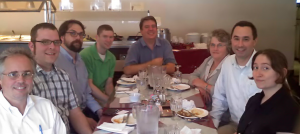Data management & curation groups
Posted on March 18, 2011 in UncategorizedThis is a short and incomplete list of universities with data management & curation groups. Each item includes the name of the local group, a link to the group’s home page, a blurb describing the focus of the group, and a sublist of group membership.
Research Data Management Service Group (Cornell)
“The Research Data Management Service Group (RDMSG) aims to: present a coherent set of services to researchers; develop a unified web presence providing general information on data management planning, services available on campus, and standard language that may be used in data management plans in grant proposals; provide a single point of contact that puts researchers in touch with specialized assistance as the need arises. The RDMSG is jointly sponsored by the Senior Vice Provost for Research and the University Librarian, and also has a faculty advisory board.” — http://data.research.cornell.edu/
- Bill Block – Cornell Institute Social & Economics Research
- Dave Lifka – Center for Advanced Computing
- Dean Krafft – Library
- Dianne Dietrich – Library
- Eric Chen – Center for Advanced Computing
- Gail Steinhart – Library
- Janet McCue – Library
- Jim Cordes – Astronomy
- Stefan Kramer – Cornell Institute for Social & Economic Research
Research Data Management (Oxford)
“The University of Oxford is committed to supporting researchers in appropriate curation and preservation of their research data, and where applicable in accordance with the research funders’ requirements.” — http://www.admin.ox.ac.uk/rdm/
- Bodleian Library (organization and documentation)
- Central University Research Ethics Committee (ethical issues)
- Departmental IT Support (backup and security)
- Intellectual Property Advisory Group (lab notebooks)
- Isis Innovation (commerical issues)
- Legal Services (legal issues)
- Oxford Digital Library (publication and preservation)
- Oxford Research Archive (publication and preservation)
- Research Services (funder policies)
- Research Technology Services (technical aspects of data management)
- The Data Library (access and discovery issues)
Research Data Services (University of Wisconsin-Madison)
“Digital curation covers cradle-to-grave data management, including storage, preservation, selection, transfer, description, sharing, access, reuse, and transformations. With the current focus on data sharing and preservation on the part of funding agencies, publishers, and research disciplines, having data management practices in place is more relevant than ever.” — http://researchdata.wisc.edu/
- Alan Wolf – Madison Digital Media Center
- Allan Barclay – Health Sciences Library
- Amanda Werhane – Agriculture & Life Science Library
- Brad Leege – DoIT Academic Technology
- Bruce Barton – DoIT Academic Technology
- Caroline Meikle – Soil Science Department/UW-Extension
- Cindy Severt – Data & Information Services Center
- Dorothea Salo – Memorial Library
- Jan Cheetham – DoIT Academic Technology
- Keely Merchant – Space Science Library
- Nancy Wiegand – Geospatial Sciences
- Rebecca Holz – Health Sciences Library
- Ryan Schryver – Engineering
Data Management and Publishing (MIT)
“What should be included in a data management plan? Funding agencies, e.g., the National Science Foundation (NSF), may have specific requirements for plan content. Otherwise, there are fundamental data management issues that apply to most disciplines, formats, and projects. And keep in mind that a data management plan will help you to properly manage your data for own use, not only to meet a funder requirement or enable data sharing in the future.” — http://libraries.mit.edu/guides/subjects/data-management/
- Amy Stout – Library – Library
- Anne Graham – Library
- Courtney Crummett – Library
- Katherine McNeill – Library
- Lisa Sweeney – Library
Scientific Data Consulting (University of Virginia)
“The SciDaC Group is ready to consult with you on your entire data life cycle, helping you to make the right decisions, so that your scientific research data will continue to be available when you and others need it in the future.” — http://www2.lib.virginia.edu/brown/data/
- Andrew Sallans – Library
- Sherry Lake – Library
Managing Your Data (University of Minnesota)
“The University Libraries are here to assist you with research data management issues through best practices, training, and awareness of data preservation issues. This site examines the research data life-cycle and offers tools and solutions for creation, storage, analysis, dissemination, and preservation of your data.” — http://www.lib.umn.edu/datamanagement
- Amy West – Library
- Lisa Johnston – Library
- Meghan Lafferty – Library
Data Management Planning (Penn State)
“Good data management starts with comprehensive and consistent data documentation and should be maintained through the life cycle of the data.” — http://www.libraries.psu.edu/psul/scholar/datamanagement.html
- Ann Holt – Library
- Daniel C. Mack – Library
- Kevin Clair – Library
- Marcy Bidney – Library
- Mike Giarlo – Library
- Nancy Henry – Library
- Nic Cecchino – Library
- Patricia Hswe – Library
- Stephen Woods – Library
Research Cyberinfrastructure (University of California-San Diego)
“Research Cyberinfrastructure offers UC San Diego researchers the computing, network, and human infrastructure needed to create, manage, and share data, and SDSC’s favorable pricing can help researchers meet the new federal requirements for budget proposals.” — http://rci.ucsd.edu/
- Ardys Kozbial – Data Curation Working Group (Libraries)
- Dallas Thornton – Cyberinfrastructure Services
- Ron Joyce – Associate Director, IT Infrastructure
- Sharon Franks – Office of Research Affairs
Distributed Data Curation Center (Purdue University)
“We investigate and pursue innovative solutions for curation issues of organizing, facilitating access to, archiving for and preserving research data and data sets in complex environments.” — http://d2c2.lib.purdue.edu/
- Elisa Bertino – Director of the Cyber Center at Discovery Park
- Gerry McCartney – Information Technology
- James L. Mullins – Dean of Libraries
- Jay Akridge – Dean of Agriculture
- Jeffrey Roberts – Dean of Science
- Leah Jamieson – Dean of Engineering











 At the most recent
At the most recent 
